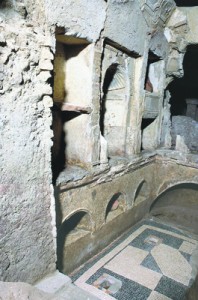VATICAN CITY (CNS) — The Catholic Church teaches that beauty can be a path to God, and in an attempt to make that path easier for visitors to follow, the Vatican Museums have assigned two priests to guide the searching. Or just to talk.
“Art and faith: A priest for you,” says the sign on the table where a priest from Togo and another from Nigeria took up their posts Aug. 1 on an experimental basis.

Bishop Giuseppe Sciacca, general secretary of the Vatican governor’s office, told Catholic News Service, “Especially as the Year of Faith is about to begin, it seemed opportune to take this pastoral initiative.”
With thousands of visitors passing through the museums each day, “we decided a discrete presence should be offered for those who feel a need to talk or seek advice. Who knows, it could even lead to a confession,” he said.
“Art is a path to beauty and truth, and therefore to God,” the bishop said.
The two pioneer priest-guides are members of religious orders — one is a Sacred Heart missionary and the other is a member of the Orionine Fathers. Both are studying at pontifical universities in Rome, and they both speak Italian, English and French.
Msgr. Paolo Nicolini, managing director of the Vatican Museums, said the Vatican is calling the assignment an experiment because “it’s something absolutely new.”
“We need to be able to understand and eventually make adjustments or — as we hope — increase it,” he said.
“Obviously, it’s not a question of evaluating this from a numerical point of view — we won’t keep a list of those who turn to the priests — but we need to know if we are meeting a real need and if we are doing it well,” the monsignor said.
Like the world’s other major museums, the Vatican Museums are packed with the old and the ancient but regularly seek new ways to display the treasures and help visitors enjoy them and learn from them.
Multimedia displays and environmental sensitivity are part of the modern museum mix, including at the Vatican Museums.
In late July, an Italian company gave the Vatican governor’s office two all-electric, 14-seat, wheelchair-accessible minivans, which the museums will use to drive visitors through the Vatican gardens without leaving a trace of exhaust behind on the flowers, fountains, lawns and woods.
Reopening of the Necropolis
Then, just a few days later, the museums announced they were reopening the necropolis of Santa Rosa, the 2,000-year-old series of tombs unearthed in 2003 when the Vatican was digging a parking garage in the northeast corner of Vatican City State. It is not connected to the underground tombs on the other side of the Vatican hill where St. Peter’s tomb is believed to be.
The necropolis was open to the public in 2006-2009, but has been closed for almost three years as archeologists excavated more of the site and renewed the tourist itinerary, including the addition of touchscreens that allow visitors to zoom in on tombs and objects, and view artistic reconstructions of what the burial grounds might have looked like before 150 AD.
Giandomenico Spinola, the director of the museums’ ancient Greek and Roman section, told CNS he hopes to have everything ready for tourists by mid-October. He said there now are 70 family tombs and some 300 to 400 single burial sites visible to visitors from a series of grated walkways suspended over the necropolis.
While August is by far the most popular time of year for Vatican employees to go on vacation, two restorers were at work Aug. 2. One was using a laser to remove incrustations from a niche in a large family tomb.
Another, working on a platform above the necropolis, was cleaning up the remains of a statue of Venus. Spinola said the statue was found, headless, in a much smaller burial ground in the early 1930s when the Vatican was building its supermarket. The piece had been in a museum storage room until the Vatican decided to add exhibition space to the necropolis.
Even when the necropolis was closed to the public, archeologists and anthropologists were frequent visitors, Spinola said. Working with Italian and French specialists, he said, the Vatican is using geo-radar to map the contours of areas still buried, probably by mudslide in ancient times.
Much of what has been uncovered in the necropolis remains where it was found, including several skeletons of children and a few of adults. The area also is filled with terracotta jars containing cremated remains.
Spinola said the necropolis has been a goldmine for anthropologists studying ancient Roman burial practices and, particularly, family relationships. “Frequently part of the children’s remains were buried with the mother and part with the father — only an anthropologist can interpret that,” he said.
